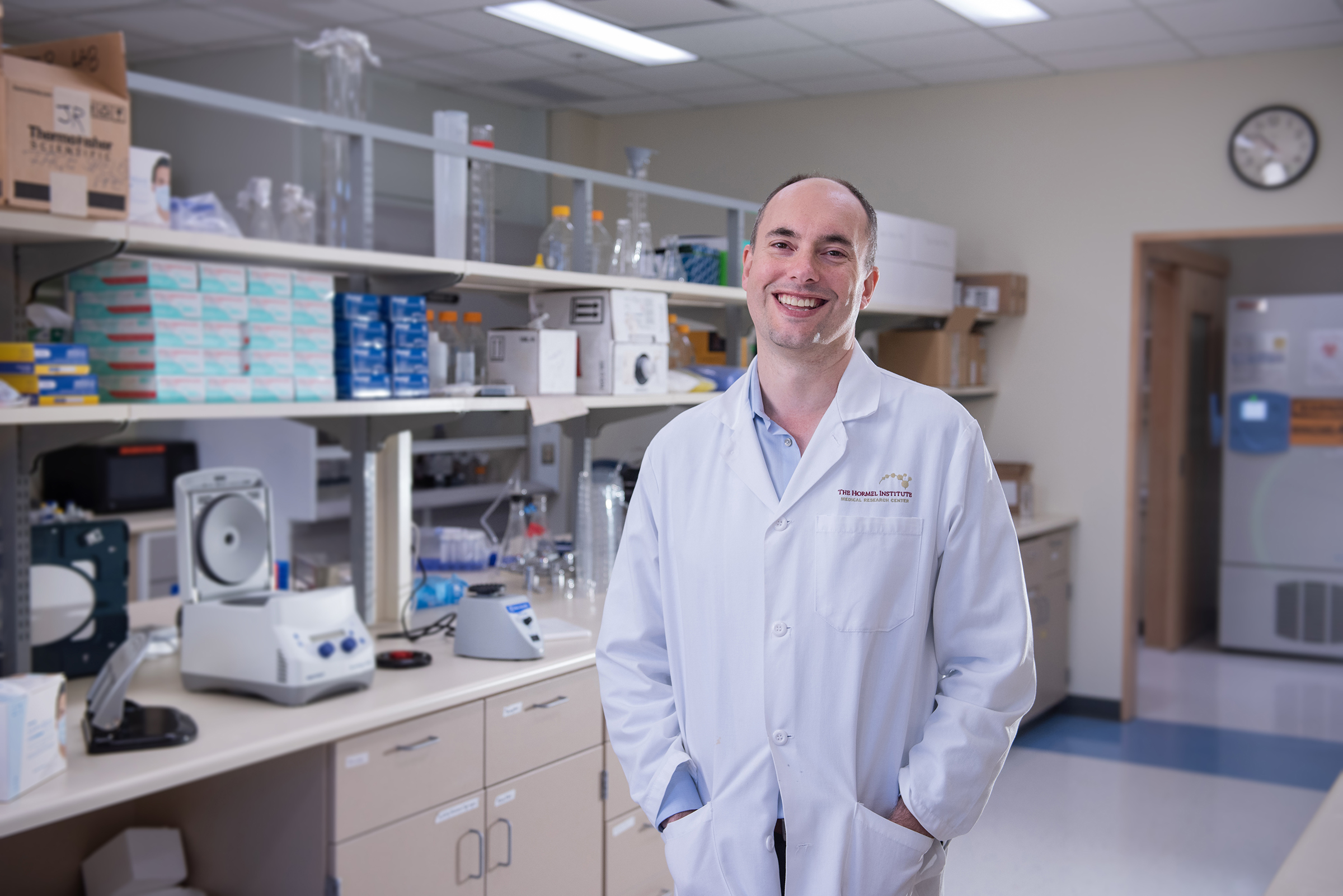
James Robinson, PhD
Associate Professor
Our section is concerned with the molecular mechanisms by which oncogenic signaling regulates Tumorigenesis, with the ultimate goal of developing and improving existing therapeutic approaches to eliminate cancer. As part of the University of Minnesota and a member of the Masonic Cancer Center (MCC), have and will continue to collaborate with worldwide experts in the fields of cell signaling, cancer research comparative pathology and genetics. We employ two experienced postdoctoral fellows, Kwan Hyun Kim, Ph.D. and Hana Yang, Ph.D, and this summer we are joined by Nick Hanson whose Undergraduate Research Experience (SURE) internship was generously funded with an Orville S. Privett Scholarship.
Publications 2017
1. H Yang, D Kircher, KH Kim, AH Grossmann, MW VanBrocklin, SL Holmen, and JP Robinson. Activated MEK cooperates with Cdkn2a and Pten loss to promote the development and maintenance of melanoma. Oncogene. 2017 Jul 6;36(27):3842-3851.
Glioma: Gliomas are the most common primary brain tumor. Glioblastoma (GBM), the highest grade of glioma (most lethal), is highly infiltrative, and is resistant to all conventional therapies. Patients with this cancer rarely survive longer than 12-14 months from the time the tumor is diagnosed. Pediatric GBM is clinically and biologically distinct from the adult disease. It typically develops in the midline or pons. While even the lowest grade of glioma in children Pilocytic astrocytoma is associated with significant morbidity diffuse intrinsic pontine glioma (DIPG), a GBM of the brain stem confers the worst prognosis of any pediatric cancer. It has a 5-year survival rate of <1%, a 1-year survival of <30% and 2 -year survival of <10 %; median survival is < 9 months (15, 16). Pediatric GBM is defined by mutations in the gene encoding Histone H3.3. We are developing an animal model (Figure 1) to study this disease. In collaboration with the Hinchcliffe lab at the Hormel Institute, we seek to bring about a better understanding of the role of this mutation in these tumors in order to develop new therapies to improve survival for children with this devastating disease.
Melanoma: Melanomas develop from melanocytes, the pigment-making cells of the skin (Figure 2).The incidence of melanoma increased 690% from 1950 to 2001, and it continues to increase at a greater rate than any other cancer. Most melanoma patients are under 60; it is the most common form of cancer for ages 25-29 and the second for ages 15-29. Five-year survival for patients with metastatic disease is less than 16%. The rapidly rising incidence coupled with the high rate of mortality associated with advanced disease is particularly troubling. The increased incidence of melanoma, combined with the poor prognosis of patients with advanced disease, make it imperative that we increase our understanding of the underlying causes of resistance to targeted therapies so that better therapeutic strategies can be developed. The mitogen-activated protein kinase pathway is constitutively activated in the majority of cutaneous melanomas, predominantly due to NRAS and BRAFV600E mutations. We have developed a novel retroviral gene delivery in vivo model of melanoma that allows for targeted delivery to melanocytes in vivo. In vivo models are immunecompetent and tumors evolve from developmentally normal somatic cells in an unaltered microenvironment. Multiple genetic alterations can be introduced into the same cell without the time and cost associated with crossing multiple strains of transgenic in vivo models. Vemurafenib and dabrafenib are FDA-approved drugs for the treatment of advanced metastatic melanomas with BRAFV600E mutations. Although the initial response to these inhibitors can be dramatic, sometimes causing complete tumor regression, the majority of these melanomas eventually become resistant and reoccur. Resistance to BRAFV600E kinase inhibitors is frequently associated with reactivation of MAPK pathway. For this reason, BRAF inhibitors are combined with MEK inhibitors; however, after a period of response and dormancy the tumors still reoccur. We recently demonstrated that gain of function MEK mutants found in drug resistant BRAF melanoma drive the de-novo development of malignant melanoma with high penetrance. We are now using next generation RNA sequencing to identify the mechanisms of tumor dormancy and recurrence following BRAF and MEK inhibition in our novel in vivo model and in human melanoma samples.
Cancer: After lung and prostate cancer, colon cancer the leading cause of cancer deaths in the United States with 132,770 new cases and 49,700 deaths anticipated in 2015. About 75% of cases are sporadic with no obvious evidence of an inherited disorder. The remaining 25% of patients have a family history of CRC that suggests a hereditary contribution, common exposures among family members, or a combination of both. Familial adenomatous polyposis (FAP), is one of the most clearly defined and well understood of the inherited colon cancer syndromes. Our preliminary data has demonstrated that loss of APC is insufficient for tumorignesis and additional growth signals or mutations are also required for nuclear accumulation of β-Catenin and intestinal polyposis. Since in vivo models of FAP develop a multitude of intestinal polyps without additional genetic alterations, these additional signals are likely to arise from adjacent stromal cells. If we can show that stromal signaling plays a driving role in tumorigenesis, following or pre-empting epithelial LOH of APC, it should be possible to develop targeted therapeutics to block this signaling. A major preliminary finding is that heterozygous mutation of APC in adult in vivo models is not sufficient cause tumor formation. Our sections work on Colon cancer is funded by the National Institutes of Health (NIH) and our ongoing studies will contribute to the development of novel therapies and improve the outcome for patients with colon cancer.
